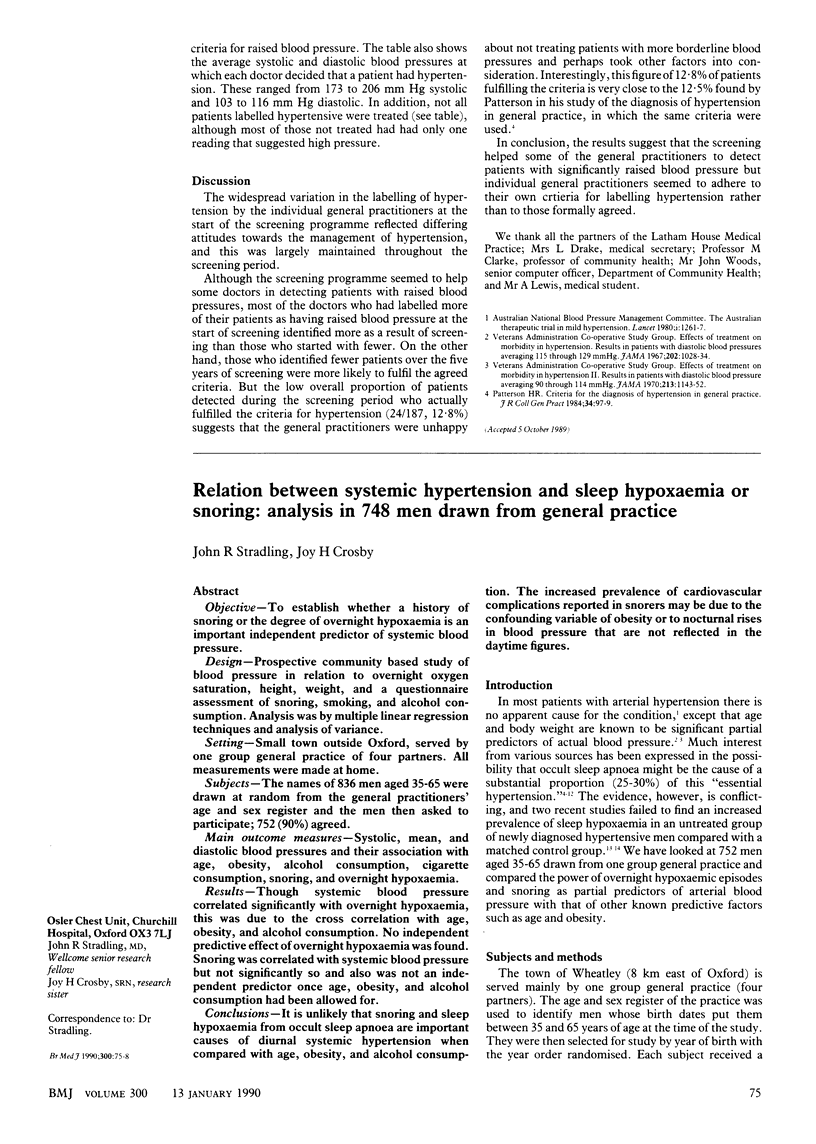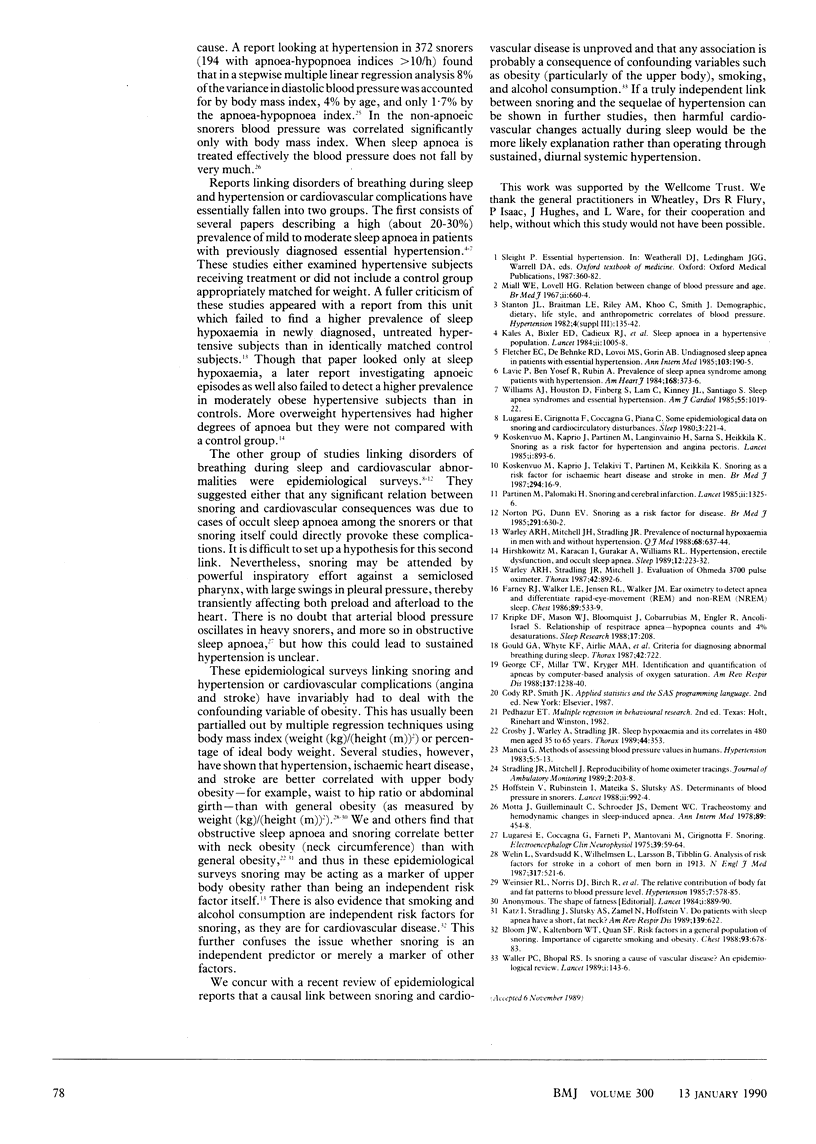Abstract
OBJECTIVE--To establish whether a history of snoring or the degree of overnight hypoxaemia is an important independent predictor of systemic blood pressure. DESIGN--Prospective community based study of blood pressure in relation to overnight oxygen saturation, height, weight, and a questionnaire assessment of snoring, smoking, and alcohol consumption. Analysis was by multiple linear regression techniques and analysis of variance. SETTING--Small town outside Oxford, served by one group general practice of four partners. All measurements were made at home. SUBJECTS--The names of 836 men aged 35-65 were drawn at random from the general practitioners' age and sex register and the men then asked to participate; 752 (90%) agreed. MAIN OUTCOME MEASURES--Systolic, mean, and diastolic blood pressures and their association with age, obesity, alcohol consumption, cigarette consumption, snoring, and overnight hypoxaemia. RESULTS--Though systemic blood pressure correlated significantly with overnight hypoxaemia, this was due to the cross correlation with age, obesity, and alcohol consumption. No independent predictive effect of overnight hypoxaemia was found. Snoring was correlated with systemic blood pressure but not significantly so and also was not an independent predictor once age, obesity, and alcohol consumption had been allowed for. CONCLUSIONS--It is unlikely that snoring and sleep hypoxaemia from occult sleep apnoea are important causes of diurnal systemic hypertension when compared with age, obesity, and alcohol consumption. The increased prevalence of cardiovascular complications reported in snorers may be due to the confounding variable of obesity or to nocturnal rises in blood pressure that are not reflected in the daytime figures.
Full text
PDF



Selected References
These references are in PubMed. This may not be the complete list of references from this article.
- Bloom J. W., Kaltenborn W. T., Quan S. F. Risk factors in a general population for snoring. Importance of cigarette smoking and obesity. Chest. 1988 Apr;93(4):678–683. doi: 10.1378/chest.93.4.678. [DOI] [PubMed] [Google Scholar]
- Farney R. J., Walker L. E., Jensen R. L., Walker J. M. Ear oximetry to detect apnea and differentiate rapid eye movement (REM) and non-REM (NREM) sleep. Screening for the sleep apnea syndrome. Chest. 1986 Apr;89(4):533–539. doi: 10.1378/chest.89.4.533. [DOI] [PubMed] [Google Scholar]
- Fletcher E. C., DeBehnke R. D., Lovoi M. S., Gorin A. B. Undiagnosed sleep apnea in patients with essential hypertension. Ann Intern Med. 1985 Aug;103(2):190–195. doi: 10.7326/0003-4819-103-2-190. [DOI] [PubMed] [Google Scholar]
- George C. F., Millar T. W., Kryger M. H. Identification and quantification of apneas by computer-based analysis of oxygen saturation. Am Rev Respir Dis. 1988 May;137(5):1238–1240. doi: 10.1164/ajrccm/137.5.1238. [DOI] [PubMed] [Google Scholar]
- Hirshkowitz M., Karacan I., Gurakar A., Williams R. L. Hypertension, erectile dysfunction, and occult sleep apnea. Sleep. 1989 Jun;12(3):223–232. doi: 10.1093/sleep/12.3.223. [DOI] [PubMed] [Google Scholar]
- Hoffstein V., Rubinstein I., Mateika S., Slutsky A. S. Determinants of blood pressure in snorers. Lancet. 1988 Oct 29;2(8618):992–994. doi: 10.1016/s0140-6736(88)90744-1. [DOI] [PubMed] [Google Scholar]
- Kales A., Bixler E. O., Cadieux R. J., Schneck D. W., Shaw L. C., 3rd, Locke T. W., Vela-Bueno A., Soldatos C. R. Sleep apnoea in a hypertensive population. Lancet. 1984 Nov 3;2(8410):1005–1008. doi: 10.1016/s0140-6736(84)91107-3. [DOI] [PubMed] [Google Scholar]
- Koskenvuo M., Kaprio J., Partinen M., Langinvainio H., Sarna S., Heikkilä K. Snoring as a risk factor for hypertension and angina pectoris. Lancet. 1985 Apr 20;1(8434):893–896. doi: 10.1016/s0140-6736(85)91672-1. [DOI] [PubMed] [Google Scholar]
- Lavie P., Ben-Yosef R., Rubin A. E. Prevalence of sleep apnea syndrome among patients with essential hypertension. Am Heart J. 1984 Aug;108(2):373–376. doi: 10.1016/0002-8703(84)90628-8. [DOI] [PubMed] [Google Scholar]
- Lugaresi E., Cirignotta F., Coccagna G., Piana C. Some epidemiological data on snoring and cardiocirculatory disturbances. Sleep. 1980;3(3-4):221–224. doi: 10.1093/sleep/3.3-4.221. [DOI] [PubMed] [Google Scholar]
- Lugaresi E. Snoring. Electroencephalogr Clin Neurophysiol. 1975 Jul;39(1):59–64. doi: 10.1016/0013-4694(75)90127-3. [DOI] [PubMed] [Google Scholar]
- Miall W. E., Lovell H. G. Relation between change of blood pressure and age. Br Med J. 1967 Jun 10;2(5553):660–664. doi: 10.1136/bmj.2.5553.660. [DOI] [PMC free article] [PubMed] [Google Scholar]
- Motta J., Guilleminault C., Schroeder J. S., Dement W. C. Tracheostomy and hemodynamic changes in sleep-inducing apnea. Ann Intern Med. 1978 Oct;89(4):454–458. doi: 10.7326/0003-4819-89-4-454. [DOI] [PubMed] [Google Scholar]
- Norton P. G., Dunn E. V. Snoring as a risk factor for disease: an epidemiological survey. Br Med J (Clin Res Ed) 1985 Sep 7;291(6496):630–632. doi: 10.1136/bmj.291.6496.630. [DOI] [PMC free article] [PubMed] [Google Scholar]
- Partinen M., Palomäki H. Snoring and cerebral infarction. Lancet. 1985 Dec 14;2(8468):1325–1326. doi: 10.1016/s0140-6736(85)92625-x. [DOI] [PubMed] [Google Scholar]
- Waller P. C., Bhopal R. S. Is snoring a cause of vascular disease? An epidemiological review. Lancet. 1989 Jan 21;1(8630):143–146. doi: 10.1016/s0140-6736(89)91153-7. [DOI] [PubMed] [Google Scholar]
- Warley A. R., Mitchell J. H., Stradling J. R. Evaluation of the Ohmeda 3700 pulse oximeter. Thorax. 1987 Nov;42(11):892–896. doi: 10.1136/thx.42.11.892. [DOI] [PMC free article] [PubMed] [Google Scholar]
- Warley A. R., Mitchell J. H., Stradling J. R. Prevalence of nocturnal hypoxaemia amongst men with mild to moderate hypertension. Q J Med. 1988 Aug;68(256):637–644. [PubMed] [Google Scholar]
- Weinsier R. L., Norris D. J., Birch R., Bernstein R. S., Wang J., Yang M. U., Pierson R. N., Jr, Van Itallie T. B. The relative contribution of body fat and fat pattern to blood pressure level. Hypertension. 1985 Jul-Aug;7(4):578–585. doi: 10.1161/01.hyp.7.4.578. [DOI] [PubMed] [Google Scholar]
- Welin L., Svärdsudd K., Wilhelmsen L., Larsson B., Tibblin G. Analysis of risk factors for stroke in a cohort of men born in 1913. N Engl J Med. 1987 Aug 27;317(9):521–526. doi: 10.1056/NEJM198708273170901. [DOI] [PubMed] [Google Scholar]
- Williams A. J., Houston D., Finberg S., Lam C., Kinney J. L., Santiago S. Sleep apnea syndrome and essential hypertension. Am J Cardiol. 1985 Apr 1;55(8):1019–1022. doi: 10.1016/0002-9149(85)90738-6. [DOI] [PubMed] [Google Scholar]


